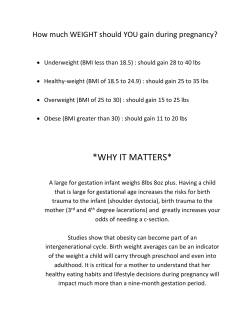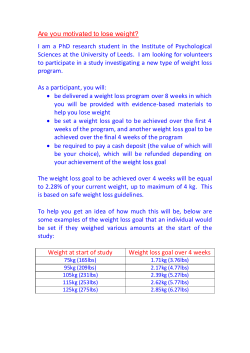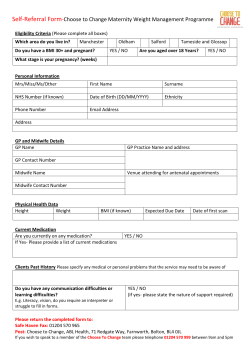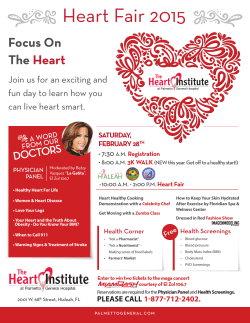
Document
www.ijraset.com IC Value: 13.98 Volume 3 Issue V, May 2015 ISSN: 2321-9653 International Journal for Research in Applied Science & Engineering Technology (IJRASET) Media Impact on Students’ Body Image Samuel Asumadu- Sarkodie*1, Phebe Asantewaa Owusu2 1, 2 School of Medicine and Health Science, University for Development Studies, Tamale, Ghana Abstract: Media promotion of the ideal body as slimness for women and muscularity for men, has led to increasing numbers of both genders reporting dissatisfaction with their bodies and trying to change using unhealthy eating habits. This research was conducted in University for Development Studies, Tamale campus. The main goal was to assess the impact of the media on university students’ attitude toward body image. The objectives of the study is to, determine whether there was any association between both positive and negative body image dissatisfaction and media exposure; determine if there was any association between body image dissatisfaction and gender; determine if an association between media exposure and peer pressure was apparent and ascertain the link between body image dissatisfaction, unrealistic expectations and BMI. A cross-sectional analytical study was conducted in University for Development Studies using a convenience sampling technique to select both male and female undergraduate students aged between 18 and 35 and a sample size of two hundred and thirty four (234) was employed using the Cochran sample size formula. Data was collected by administering structured questionnaire and it was analysed using SPSS and Excel respectively. The results from the study showed that the prevalence of negative body image dissatisfaction was higher males (50.4%) as compared to female (49.6%). In addition, men had a higher prevalence of positive body image dissatisfaction (60.4) compared to women (39.6%). With regards to the difference in peer pressure in males and females, our study produced a vivid results. In females, the prevalence of peer pressure was higher 78 (73.6%) as compared to males 60 (46.9%). From the results of the study, it became clear that, BMI is associated with body image dissatisfaction as it is noted in other literature on the same study in western countries (p <0.01). Our study concluded that, the media has no impact on university students’ attitude toward body image. It appears that media exposure does not affect body image dissatisfaction immediately but it is a dumb process that causes individuals to have a lower body image that leads to dissatisfaction. Keywords: body image; media promotion; body image dissatisfaction; Ghana Nomenclature Greek symbols χ2 Chi square value r Pearson’s Correlation co-efficient I. INTRODUCTION Human society has always valued beauty of the human body, but a person’s perception of their own body may not correspond to society’s standards. Paul Schilder in his masterpiece “the image and appearance of the human body” defined body image as a person’s perception of the artistic and sexual attractiveness of their own body [32]. The idea of body image has being in literature in numerous disciplines including; psychology, medicine, psychiatry, psychoanalysis, philosophy, cultural and feminist studies. The term is also often used in the media. In the western countries, the focus on body image as being increasing day-by-day. Pictures of movie stars and fashion models strongly impact on girl’s body shape and image perception [2]. Such mass media and diverse sociocultural pressures are seen to cause an increased awareness of being thin as ideal, and to contribute to the misperception of body weight: how the body is viewed and evaluated by the individual and by others. There is increasing pressure during adolescence as they strive to achieve the desire body shape that conforms to the thin shape for women and a lean, muscular shape for men [3]. These perceived ideal body shapes are reinforced by the mass media and popular cultural icons. Internalization of body ideals that are upheld by the media can be a strong influence on body dissatisfaction, especially among females [4]. Body image perception varies greatly among males and females within the same age group [5]. In recent years, several studies have concluded that females have a higher tendency to declare themselves as not conforming to weight ideals as compared to males. This has been seen to be more prevalent in young female adults [6]. In addition to actual weight, perceived weight status is an important determinant of eating and weight-loss behaviour [7]. However, it is important to note that perceived weight does not always reflect actual weightstatus based on body mass index (BMI). ©IJRASET 2015: All Rights are Reserved 460 www.ijraset.com IC Value: 13.98 Volume 3 Issue V, May 2015 ISSN: 2321-9653 International Journal for Research in Applied Science & Engineering Technology (IJRASET) Studies have shown that despite low rates of obesity, many university students, especially women, perceive themselves as overweight [7]. This is of concern, because inappropriate weight perceptions can lead to unhealthy behaviours including eating disorders [7]. Universities and colleges, on the other hand, represent an opportunity for reaching a large number of students to promote appropriate weight perceptions and healthy eating behaviours [8]. Croll J, argued that, body image concern is associated with chronic dieting, unhealthy weight control behaviors [9], poor self-esteem, depression [10], and the development of eating disorders [6]. Scott P., in a US study of 522 university students demonstrated that high levels of weight concern and binge eating behavior were associated with decreased levels of life satisfaction [11]. It a research conducted by George VA, and Johnson P., on young adults in American during college years, young adults attempt to develop their own lifestyle patterns including exercise and dietary intake, which may affect weight control behaviors later in life. University culture can influence how students perceive themselves as well as their strategies for changing weight [12]. A number of studies have defined the prevalence of body image concern among young women as normative discontent [13]. It has been reported that around 80 to 90% of college women were dissatisfied with their body image [14]. Body Mass Index is regarded as the significant factor associated with body dissatisfaction among adolescents and adults [15]. This salient index is a commonly used method for measuring an individual‘s body weight in relation to their height. It has been suggested that Body Mass Index (BMI) is strongly correlated with levels of body dissatisfaction: individuals with higher BMI scores are more likely to be more dissatisfied with their current bodies and desire to be thinner [16]. Research has also shown that the effect of BMI was stronger in females than males [15]. Interestingly, a UK study of 458 adolescents found that actual body weight was strongly correlated with the ideal body shape preference, implying that heavier girls were less likely to choose a thinner ideal body image, compared to thinner girls [17]. Logically, Body Mass Index is based on the same average body composition for men and women, which is useful for general analysis of weight categories: underweight (BMI<20), normal (BMI =20-24.99), overweight (BMI=25-29.99), and obese (BMI >30) [18]. Yet, this measurement can be misleading. For example, an athlete may have a Body Mass Index (BMI) above 30 but still look muscular and lean. According to Forbes, the media is able to influence people in many ways, particularly through the presentation of the idealized body image. This can be seen from many sources including television, film, music videos, newspapers, magazines and more recently Internet sites. Moreover, it has been reported that exposure to this ideal image can increase the awareness and internalization of this ideal, which results in high levels of body image concern [19]. Hausenblas et al., argues that, both women and men are bombarded with the portrayal of thin and muscular models depicted in the media. As a result of being pressurized to attain those ideals, an increasing number of people report being dissatisfied with their body image and engaging in weight change behaviors [20]. It is noteworthy that there are two types of images which women receive from the media: Artificial Beauty and Genetic Realities [21]. It is clear that the media is not only presenting the thin body ideal but also transmitting this ideal to women, as evidence shows that exposure to the thin body ideal in the media can negatively affect women‘s body satisfaction. One US study found that the body size of movie actresses and models in magazines has now dropped to about 80% of the population mean [22]. The muscular body ideal of men is becoming widespread across ethnic groups. It has been suggested that the more men from other ethnic groups acculturate westernized media images, the more they become dissatisfied and concerned with their body image [9]. This section will review the relevant theories and studies examining the effect of the media on body image dissatisfaction and the attempt to change weight across all age groups. Most of the plausible mechanisms explaining the effect of the media on self-perceptions of current and ideal body images involve the standard of thinness for women and muscularity for men [23]. Cusumano and Thompson hypothesized that women during adolescence were considered at most risk from the effect of media exposure on awareness and internalization of the thin ideal [24]. Research has shown that women and men learn to objectify the thin and muscular ideal body at a young age [25]. The impact of the media on body image in Ghana has not being greatly. Yet, it has been established as a public health problem in western countries. Against this background, the study deems to examine the validity of this claim and if so be true, what are the causal factors pertaining to this claim. II. MATERIALS AND METHOD A cross-sectional analytical study was employed in the survey to assess both exposure (nutrition, and other lifestyle variables) and outcome (anthropometric measurements) at the same time. Cochran’s sample size formula for categorical data was used to calculate the sample size of two hundred and thirty four respondents. (1) ©IJRASET 2015: All Rights are Reserved 461 www.ijraset.com IC Value: 13.98 Volume 3 Issue V, May 2015 ISSN: 2321-9653 International Journal for Research in Applied Science & Engineering Technology (IJRASET) Where sample size Z = Z statistic for a level of confidence, P = expected prevalence or proportion, and d = precision. A structured questionnaire was employed to access demographic information, nutrition, anthropometric measurements and lifestyle which includes: body image perception, body shape dissatisfaction, body image concerns, social support, stress and weight management, and exposure to the media. Anthropometric measurements were taken using an electronic uniscale (UNICEF 2008) with an error of ±0.1kg for weight whilst height were taken with an error of ±0.1cm using a microtoise (wall-mount retractable nonstretch tape). Basal Metabolic Index (BMI) was calculated from the measured weight and height. The following analyses of weight categories were employed: underweight (BMI<20), normal (BMI =20-24.99), overweight (BMI=25-29.99), and obese (BMI >30) [18]. Data analysis and presentation was done with the help of Statistical Package for the Social Sciences (SPSS) and Excel. SPSS was used to analyze Body Image Dissatisfaction (BID) variables and a scoring system developed to measure the duration spent on different modalities in each type of media stated in the questionnaire. Continuous variables were expressed as a standard error of the mean whilst categorical variables were expressed as percentages and/or proportions. Levels of association were estimated using Chisquare and Pearson's correlation analyses, and a p<0.05 was set as the level at which differences were accepted as being statistically significant. III. RESULTS AND DISCUSSION Two hundred and thirty four (234) questionnaires were administered to students within the University for Development Studies, Tamale. 45.3% of the respondents were female and 54.7% were male. In Table 1, a distribution of age and gender are given. Gender Female Male Total 17-20 37 16 53 Table 1: The distribution of age and gender Age Total 21-25 26-30 31-35 61 8 0 106 89 19 4 128 150 27 4 234 Percentage (%) 45.3 54.7 100.0 To determine the association between body image dissatisfaction and gender, the survey analyzed issues pertaining to body image self-assessment, size acceptance, and shape satisfaction. The survey was based on three areas: body image perception, body dissatisfaction and body image concern. Body image perception was categorized into positive and negative perceptions based on response given by the subjects during the survey. From a total of 106 female surveyed, 50.9% had negative perception of body image whilst 49.1% had positive perception of body image. From a total of 128 male surveyed, 65.6% had positive perception of body image whilst 34.4% had negative perception of body image. In Table 2, a distribution of body image perceptions in relation to gender are given. A write up from the analysis: χ2 (1, N = 234) = 6.54, p = 0.01. Gender Female Male Table 2. Body mage perceptions in relation to gender Body Image Perceptions Positive Perception Negative Perception 49.1% 50.9% 65.6% 34.4% Chi Square Value= 6.54 p = 0.01 From the survey, 81.6% respondents were satisfied with their current body shape whiles, 18.4% were dissatisfied with their current ©IJRASET 2015: All Rights are Reserved 462 www.ijraset.com IC Value: 13.98 Volume 3 Issue V, May 2015 ISSN: 2321-9653 International Journal for Research in Applied Science & Engineering Technology (IJRASET) body shape. In Table 3, a distribution of satisfaction with current body shape is given. Table 3. Current body shape satisfaction Body Shape Satisfaction Yes Percentage (%) 81.6 No 18.4 From the study, 56.8% respondents had a negative BID score while 43.2% had a positive BID score. Out of the 56.8% respondents with a negative BID score, 28.6% were male, while 28.2% were female. In Table 4, a distribution of body image dissatisfaction in relationship to gender is given. A write up from the analysis: χ2 (1, N = 234) = 2.3, p = 0.1. Gender Female Male Table 4. Body image dissatisfaction in relationship with gender Body Image Dissatisfaction (BID) Positive Bid Score Negative Bid Score 17.1% 28.2% 26.1% 28.6% Chi Square Value= 2.3 p = 0.1 Body image lifestyle was categorized into positive and negative lifestyles based on response given. From 106 female surveyed, 57.5% had negative body image lifestyle while 42.5% had positive body image lifestyle. From the 128 male surveyed, 55.1% had negative body image lifestyle whilst 46.9% had positive body image lifestyle. In Table 5, a distribution of body image lifestyle in relationship with gender are given. A write up from the analysis: χ2 (1, N = 234) = 0.5, p = 0.5. Gender Female Male Table 5. Body image lifestyle in relationship with gender Attitude Toward Body Image Chi Square Value= 0.5 p = 0.5 Positive Attitude Negative Attitude 42.5% 57.5% 46.9% 55.1% To ascertain the relationship between body image dissatisfaction, unrealistic expectations and BMI, issues pertaining to body mass index, exercise, stress, and weight management practices were analyzed. From 106 female surveyed, 28.2% were normal weight, 10.3% were underweight, 6.0% were overweight and 0.9% was obese. Out of 128 male surveyed, 29.5% were normal weight, 21.4% were underweight, 3.4% were overweight, and 0.4% was obese. In Figure 1, Basal Metabolic Index (BMI) classifications in relationship with gender are given. Fig. 1. BMI classifications in relationship with gender ©IJRASET 2015: All Rights are Reserved 463 www.ijraset.com IC Value: 13.98 Volume 3 Issue V, May 2015 ISSN: 2321-9653 International Journal for Research in Applied Science & Engineering Technology (IJRASET) From 106 female surveyed, 23.1% did exercise at times to keep them fit and healthy, 14.1% did not exercise regular to keep them fit and 8.1% exercised regularly to keep them fit; 23.9% agreed exercise has helped in correcting their body shape, and 21.4% disagreed; 63.2% had positive weight management practices, and 36.8% had negative weight management practices; , 28.6% were stressed within the last month due to studies in general, 3.8% were stressed within the last month due to financial situations, and 12.8% were stressed within the last month due to workload in addition to studying. Out of 128 male surveyed, 28.6% did exercise at times to keep them fit and healthy, 6.8 did not exercise regular to keep them fit and 19.2% exercised regularly to keep them fit and healthy; 37.2% agreed exercise has helped in correcting their body shape, and 17.5% disagreed; 76.6% had positive weight management practices, and 23.4% had negative weight management practices; 27.8% were stressed within the last month due to studies in general, 9.8% were stressed within the last month due to financial situations, and 17.1% were stressed within the last month due to workload in addition to studying. In Table 6, variables to analyze exercise, stress, and weight management practices in relationship with gender are given. A write up analysis for weight management practices: χ2 (1, N = 234) = 4.97, and p = 0.03. Table 6: Exercise, stress, and weight management practices in relationship with gender Variables Gender (%) Chi Square Value Female Male Yes 8.1 19.2 No 14.1 6.8 At times 23.1 28.6 Yes 23.9 37.2 No 21.4 27.5 Positive management Practices 63.2 76.6 Negative management Practices 36.8 23.4 Studies 28.6 27.8 Finances 3.8 9.8 Work and studies 12.8 17.1 Exercise Body corrected by exercise Weight management Practices 4.97 p = 0.03 Stress within a month In the assessment of positive body image dissatisfaction in relationship with BMI classifications, the following are the results; underweight (2.0%), normal weight (95%), overweight (3.0%), and obese (.0%). On the contrary, the results for negative body image dissatisfaction in relationship with BMI classifications are; underweight (54.1%), normal weight (29.3%), overweight (14.3%), and obese (2.3%). In Table 7, a distribution of body image dissatisfaction in relationship with BMI classification standard is given. A write up from the analysis: χ2 (1, N = 234) = 1.03, p < 0.01, and r (234) =.-28, p <0.01. ©IJRASET 2015: All Rights are Reserved 464 www.ijraset.com IC Value: 13.98 Volume 3 Issue V, May 2015 ISSN: 2321-9653 International Journal for Research in Applied Science & Engineering Technology (IJRASET) Table 7: Body image dissatisfaction in relationship with BMI classification standard BID Score BMI Classification Standard Chi Square Value= 1.03 Underweight Normal Overweight Obese p < 0.01 Positive BID % 2.0 95.0 3.0 .0 Negative BID % 54.1 29.3 14.3 2.3 To estimate the effect of peer pressure on body image dissatisfaction, the survey collected data pertaining to perceived influence from family members and friends; comments, social support, and encouragement towards weight changes. Comments from family and friends about ones’ body image were categorized into positive and negative comments based on response given by the subjects during the survey. From 106 female surveyed 55.2% had positive comments about their body image, and 44.8% had negative comment about their body image? From 128 male surveyed 74.2% had positive comment about their body image, and 25.8% had negative comment about their body image? In Table 8, a distribution of comments from family and friends in relationship with gender are given. A write up from the analysis: χ2 (1, N = 234) = 9.21, and p = 0.02. Gender Female Male Table 8: Comments from family and friends in relation to gender Comments From Family and Friends Positive Comments Negative Comments 55.2% 44.8% 74.2% 25.8% Chi Square Value= 9.21 p = 0.02 Out of the total of the 106 females, 33.2% had high peer pressure, and 12.0% had low peer pressure. Out of the total of the 128 males, 25.6% had high peer pressure, and 29.1% had low peer pressure. A write up from the analysis: χ2 (1, N = 234) = 17.1, and p = 0, (Table 13). Table 9: A table showing the distribution of peer pressure in relation to gender is given. Peer Pressure Score (PPS) Chi Square Value= 17.1 Gender p=0 Low Peer Pressure High Peer Pressure Female Male 12.0% 29.1% 33.3% 25.6% From the 234 respondents surveyed, 23.5% of respondents with positive body image dissatisfaction had high peer pressure whilst 19.7% of respondents with positive body image dissatisfaction had low peer pressure; on the contrary, 35.5% of respondents with negative body image dissatisfaction had high peer pressure whilst 21.4% of respondents with negative body image dissatisfaction had low peer pressure. In Table 9, distributions of body image dissatisfaction in relationship with peer pressure are given. A write up from the analysis: χ2 (1, N = 234) = 1.5, p = 0.2, and r (234) = .08, p = 0.2. Table 10: Body image dissatisfaction in relationship with peer pressure Body Image Dissatisfaction Score Peer Pressure Score (PPS) Positive BID Score Negative Bid Score 19.7% 21.4% LPP HPP 23.5% 35.5% Chi Square Value= 1.5 p = 0.2 To quantify media exposure, the degree of media exposure was categorized into high exposure (<33) and low exposure (>33). Consequently the scores were combined to give the overall exposure of an individual to mass media. ©IJRASET 2015: All Rights are Reserved 465 www.ijraset.com IC Value: 13.98 Volume 3 Issue V, May 2015 ISSN: 2321-9653 International Journal for Research in Applied Science & Engineering Technology (IJRASET) From 106 female surveyed 33.0% had low exposure to the media, while 12.0% had high exposure to the media. From 128 male sampled 34.0% had low exposure to the media while 21.0% had high exposure to the media. In Figure 2, a bar chart distribution of media exposure in relationship with gender is given. Fig. 2. Media exposure In overall analysis, 66.7% had low exposure to the media while 33.3% had high exposure to the media. In Figure 3, a pie chart showing the distribution of media exposure in relationship with both genders is given. A write up from the analysis: χ2 (1, N = 234) = 2.7, p = 0.1. From 234 respondents surveyed, 29.9% with positive body image dissatisfaction had low media exposure, 13.2% with positive body image dissatisfaction had high media exposure whilst 37.2% with negative body image dissatisfaction had low media exposure, and 19.7% with negative body image dissatisfaction had high media exposure. In Table 11, distributions of media exposure in relationship with body image dissatisfaction are given. A write up from the analysis: χ2 (1, N = 234) = 0.4, p = 0.5 and r (234) = 0.04, p = 0.5. Fig. 3. Media exposure in relationship with both genders ©IJRASET 2015: All Rights are Reserved 466 www.ijraset.com IC Value: 13.98 Volume 3 Issue V, May 2015 ISSN: 2321-9653 International Journal for Research in Applied Science & Engineering Technology (IJRASET) Media Exposure Low Exposure High Exposure Table 11: Media exposure in relation to body image dissatisfaction Body Image Dissatisfaction Score Positive BID Score Negative BID Score 29.9% 37.2% 13.2% 19.7% Chi Square Value= 0.4 p = 0.5 From the results of the study, it became clear that, males have high media exposure 49 (62.8%) than females 29 (37.2%) which is in agreement with report of GDHS, (2008) which outlined that, men are more likely to get access to the media that women [27]. From Pearson’s correlation values: r (234) = .04, p = .53, the p-value is nowhere near alpha (.05); in other words, because the pvalue exceeds alpha, it is not statistically significant. Thus we fail to reject the null, and conclude that body image dissatisfaction has a weak relationship with media exposure. In addition, Pearson’s chi square value is 0.39 and p = 0.53. Since, significance level is more than .05, there is no significant difference. Therefore, we can say that the two variables are not associated. Whether or not one has positive or negative body image dissatisfaction does not depend on whether or not one is exposed to the media as it is noted in other literature on the same study in western countries. This may be due to level of education and household wealth status. GSS and ORC Macro, (2004) confirmed in Ghana that, exposure to mass media is positively associated with level of education and household wealth status; the proportion exposed to all three media increases with level of education and wealth quintile [28]. With regards to the difference in image dissatisfaction in males and females, our study produced interesting results. In males, the prevalence of negative body image dissatisfaction was higher (50.4%) as compared to females (49.6%). In addition, men had a higher prevalence of positive BID (60.4%) compared to women (39.6%). Pearson’s chi square value is 2.7 and p = 0.1. Since, significance level is more than .05, there is no significant difference. Thus we fail to reject the null, and conclude that body image dissatisfaction is not associated with gender. Whether or not one has positive or negative body image dissatisfaction does not depend on whether one is a male or female as it is noted in other literature on the same study in western countries. This is in contrast with other literature on this topic which shows that negative body image dissatisfaction is more prevalent in women than men [29]. It has been reported that women were most likely to perceive themselves as being overweight; resulting in a high prevalence of body image dissatisfaction and unhealthy eating behaviors [30 ]which is not so in a developing country like Ghana because, overweight women are viewed as being attractive. On the other hand, the self-perception of being underweight also had an effect on appearance evaluation, particularly for men [31]. There is no single unified scale to quantify this parameter and hence the disparity in results could be attributed to this fact. However, we feel this is not the case because in essence, all the scales are looking to quantify the same variable; body image dissatisfaction. The fact that all the studies based their findings on similar questions ascertaining the subjects’ body image, combined with the highly significant results in all the papers, can only mean that the literature is correctly in agreement on body image dissatisfaction being higher in women in the western countries as well as a developing country like Ghana. With regards to unrealistic expectations and unhealthy eating habit due to body image dissatisfaction in both gender, our study produced interesting results. 79.1% were satisfied with the support they receive from their family when they are down, 56.4% were stressed in the last month by academics, 51.7% exercise at times to keep healthy, 61.1% confirmed exercise has helped them in correcting their body shape, and 57.7% doesn’t fancy fitness products on television. From the results of the study, it became clear that, 95% of positive body image dissatisfaction were among those with normal body weight whiles, 54.1% of negative body image dissatisfaction were among underweights. From Pearson’s correlation value: r (234) =.-28, and p <0.01, because the p-value is less than the alpha, it is statistically significant. Thus we reject the null, and conclude that body image dissatisfaction is negatively related to BMI. This significant results is in agreement with the literature that has been suggested that Body Mass Index (BMI) is correlated with levels of body dissatisfaction: individuals with higher BMI scores are more likely to be more dissatisfied with their current bodies and desire to be thinner [16]. In addition, Pearson’s chi square value is 1.03 and p <0.01. Since, significance level is less than .01 or .05, there is significant difference. Therefore, we can say that the two variables are associated. Whether or not one has positive or negative body image dissatisfaction depends on BMI. The study strongly agrees that Body Mass Index is considered as the salient factor associated with ©IJRASET 2015: All Rights are Reserved 467 www.ijraset.com IC Value: 13.98 Volume 3 Issue V, May 2015 ISSN: 2321-9653 International Journal for Research in Applied Science & Engineering Technology (IJRASET) body dissatisfaction among adolescents and adults [15]. IV. CONCLUSIONS Analysis from our study suggests that, the claim media affects body image dissatisfaction is not valid. It appears that media exposure may not affect body image dissatisfaction immediately but it is a dumb process that causes individuals to have a poor body image satisfaction which may lead to dissatisfaction. Even though it has been proven in literature that the media influences body image dissatisfaction in western countries, mutatis mutandis, it is not certain in Ghana due to the results of our study. In order to arrive at concrete evidence that the media influences body image dissatisfaction among individuals in Ghana and developing countries at large, further research should be conducted with large sample size in order to ascertain if it truly correlates with the evidence that has been established in western countries. It was evident in our study that body mass index greatly affects body image dissatisfaction of students, the prevalence been higher in males than females. The notion that black communities view overweight women as being attractive is true among the large populace but not true from an individuals’ point of view. Because, all overweight women that were part of the study were not satisfied with their weight and wanted to lose weight to gain the normal weight according to the BMI indicators. Unhealthy eating habits were not identified as a major problem among the students; they will rather exercise more to lose weight than to skip meals or take medications. With the exception of BMI satisfaction, almost all the results from the study were inconsistent with other studies on the same subject in western countries. Yet, our study infers that either university students are not influenced by the media exposure due to; their level of education, satisfaction with their body image or media exposure is not high enough to be statistically significant. REFERENCES [1] [2] [3] [4] [5] [6] [7] [8] [9] [10] [11] [12] [13] [14] [15] [16] [17] [18] [19] [20] [21] [22] Cochran, W. G. (2007). Sampling techniques. John Wiley & Sons. Field AE, Cheung L, Wolf AM, Herzog DB, Gortmaker SL. Exposure to the mass media and weight concerns among girls. Pediatrics 1999; 103(3):E36. McCabe MP, Ricciardelli LA. A longitudinal study of body change strategies among adolescent males. J Youth Adolesc 2003; 32(2):105-13 Knauss C, Paxton SJ, Alsaker FD: Relationships amongst body dissatisfaction, internalization of the media body ideal and perceived pressure from media in adolescent girls and boys. Body Image 2007,4:353-360 Groesz LM, Levine MP, Murnen SK. The effect of experimental presentation of thin media images in body satisfaction: A meta-analytic review. Int J Eat Disord 2002; 31:1-16. Prevos P. (2005). Differences in body image between men and women. Available at: http://www.prevos.net/ola/body_image.pdf. Accessed on: 8th May, 2006 Bellisle F, Monneuse MO, Steptoe A, Wardle J: Weight concerns and eating patterns: a survey of university students in Europe. Int J Obes Relat Metab Disord 1995, 19(10):723-730. Sepulveda AR, Carrobles JA, Gandarillas A, Poveda J, Pastor V: Prevention program for disturbed eating and body dissatisfaction in a Spanish university population: a pilot study. Body Image 2007, 4(3):317-328 Croll, J. (2005). Body image and adolescents. Chest (in), 40(35), 50. Furnham A, Boughton J. Eating behavior and body dissatisfaction among dieters, aerobic exercisers and a control group. European Eating Disorders Review 1995; 3(1):35-45 Scott P. Weight perceptions, dieting behaviors, and perceived satisfaction with life among university students, Proceedings of the 133rd Annual meeting and exposition of American Public Health Association; 2005 December 10-14; Philadelphia, USA. George VA, Johnson P. Weight loss behaviors and smoking in college students of diverse ethnicity. American Journal of Health Behaviors 2001; 25(2):115-24. Lowery SE, Kurpius SER, Befort C, Blanks EH, Sollenberger S, Nicpon MF, et al. Body image, self-esteem, and health-related behaviors among male and female first year college students. Journal of College Student Development 2005; 46(6):612-23. Drewnowski A, Yee DK. Men and body image: Are males satisfied with their body weight? Psychosom Med 1987; 49:626-34. Smolak L. Body image in children and adolescents: where do we go from here? Body Image 2003; 1:15-28 Wong Y, Chen SL, Chan YC, Wang M, Yamamoto S. Weight satisfaction and dieting practices among college males in Taiwan. J Am Coll Nutr 1999; 18(3):223-8. Dittmar H, Lloyd B, Dugan S, Halliwell E, Jacobs N, Cramer H. The "body beautiful": English adolescents' images of ideal bodies. Sex Roles 2000; 42:887915. Lappalainen R, Tuomisto M, Giachetti I, Amicis AD, Paquet S, Recent body weight changes and weight loss practices in the European Union. Public Health Nutr 1999; 2(1a):135-41. Forbes GB, Doraszewicz K, Card K, Adam-Curtis L. Association of the thin body ideal, ambivalent sexism, and self-esteem with body acceptance and the preferred body size of college women in Poland and the United States. Sex Roles 2004; 50:331-45. Hausenblas HA, Janelle C, Gardner R, Hagan A. Effects of exposure to physique slides on the emotional responses of men and women. Sex Roles 2002; 47(11-12):569-75. Yamamiya Y, Cash TF, Melnyk SE, Posavac HD, Povasac SS. Women's exposure to thin-and-beautiful media images: Body image effects of media-ideal internalization and impact-reduction interventions. Body Image 2005; 2:74-80. Turner SL, Hamilton H, Jacobs M, Angood L, Dwyer D. The influence of fashion magazine on the body image satisfaction of college women: an exploratory ©IJRASET 2015: All Rights are Reserved 468 www.ijraset.com IC Value: 13.98 Volume 3 Issue V, May 2015 ISSN: 2321-9653 International Journal for Research in Applied Science & Engineering Technology (IJRASET) [23] [24] [25] [26] [27] [28] [29] [30] [31] [32] analysis. Adolescence 1997; 32(127):603-14. Halliwell E, Harvey M. Examination of a sociocultural model of disordered eating among male and female adolescents. Br J Health Psychol 2006; 11:235-48. Cusumano DL, Thompson JK. Body image and body shape ideals in magazines: Exposure, awareness, and internalization, Sex Roles 1997; 37:701-21. Murnen SK, Smolak L, Mills JA, Good L. Thin, sexy women and strong, muscular men: Grade-school children's responses to objectified images of women and men. Sex Roles 2003; 49:427-437. Lieberman M, Gauvin L, Bukowski WM, White DR. Interpersonal influence and disordered eating behaviors in adolescent girls: The role of peer modeling, social reinforcement, and body-related teasing. Eat Behav 2001;2:215-36 Ghana Demographic and Health Survey (GDHS), 2008 Ghana Statistical Service (GSS), Noguchi Memorial Institute for Medical Research (NMIMR), and ORC Macro. 2004. Ghana Demographic and Health Survey 2003. Calverton, Maryland: GSS, NMIMR, and ORC Macro Botta RA: Television images and adolescent girls’ body image disturbance. J Commun 1999, 49(2):22-41. Serdula MK, Collins ME, Williamson DF, Anda RF, Pamuk E, Byers TE.Weight control practices of US adolescents and adults. Ann Intern Med 1993; 119(7):667-71. Cash TF, Winstead BA, Janda LH. The great American shape-up: body image survey report, Psychol Today 1986; 20:30-7. Schilder, P. (2013). The image and appearance of the human body. Routledge. ©IJRASET 2015: All Rights are Reserved 469
© Copyright 2025









